Content
- 0.1 1. Phalaenopsis orchid, miltonia orchid and encyclia orchid
- 0.2 2. Chlorophytum
- 0.3 3. Succulents (among the people stonecrop)
- 0.4 4. Cacti
- 0.5 5. Crotons (Codiaeum)
- 0.6 6. Euphorbia
- 0.7 7. Aloe
- 0.8 8. Cyclamen
- 0.9 9. Passionflower
- 0.10 10. Azalea
- 0.11 11. Catharanthus ("cayenne jasmine")
- 0.12 12. Agave
- 0.13 13. Plants from the jungle family
- 0.14 14. Anthurium
- 0.15 15. Amaryllis, or house lily
- 0.16 16. Pelargonium (geranium)
- 1 plants for warm southern windows
It's no secret that lighting plays an important role in the life and development of a plant. Someone needs constant attention of the sun, while someone calmly goes through the "dark" times on the windowsills of the northern direction. In its
article
about the choice of plants for the kitchen, I mentioned some representatives of the windows of southern solar directions. I propose to get to know them better.

1. Phalaenopsis orchid, miltonia orchid andorchidencyclia
These delicate flowers resembling flying butterflies, contrary to belief, are not so difficult to grow. Before buying, you need to pay attention so that there are no spots on the leaves, their color should be uniform and juicy, the roots are gray-silver in color.
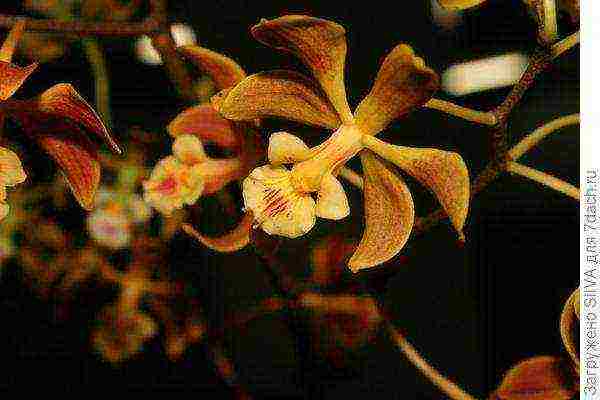

My close friend's windows face the southeast, on her windowsill many phalaenopsis and encyclias have been blooming for 4 years in a row.
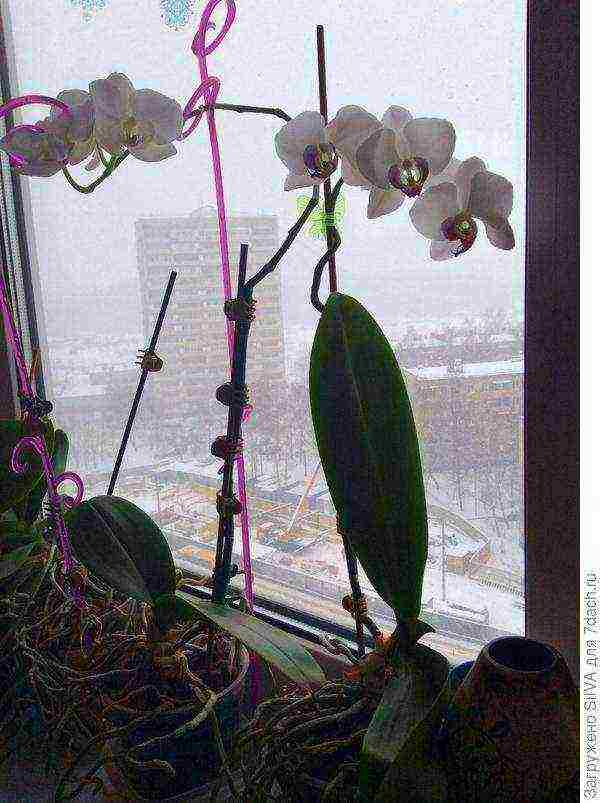
Many plants with decorative leaves will also like windows of this direction, because light affects the decorativeness and intensity of their color. These include:
2. Chlorophytum
A popular plant that is unpretentious to all conditions.
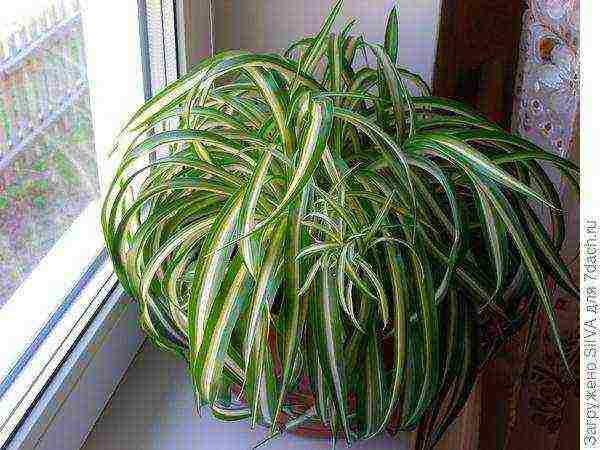
3. Succulents (among the people stonecrop)
Plants with fleshy, thick, succulent leaves. By growing them in a container, you can make a kind of art object in the kitchen that attracts attention and sets the tone for the kitchen. The only thing worth paying attention to is the family to which the plant of this group belongs, because many succulents, for example, the euphorbia family, can contain poisonous sap.
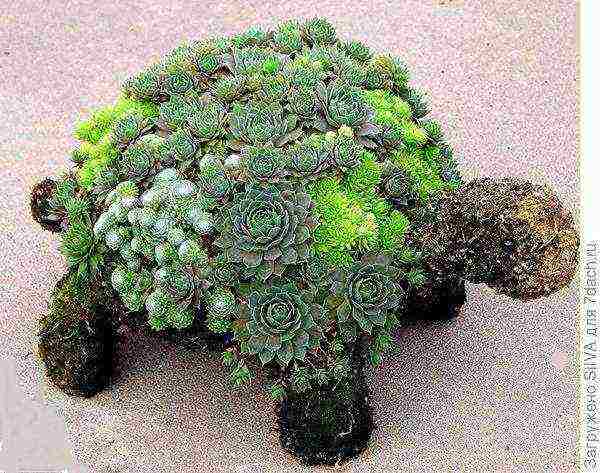
Blooming succulents
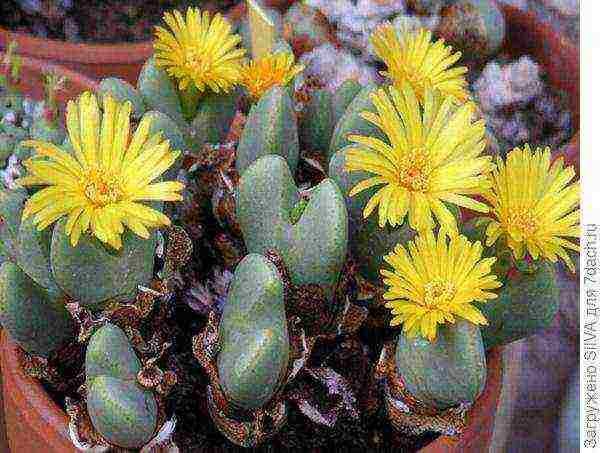
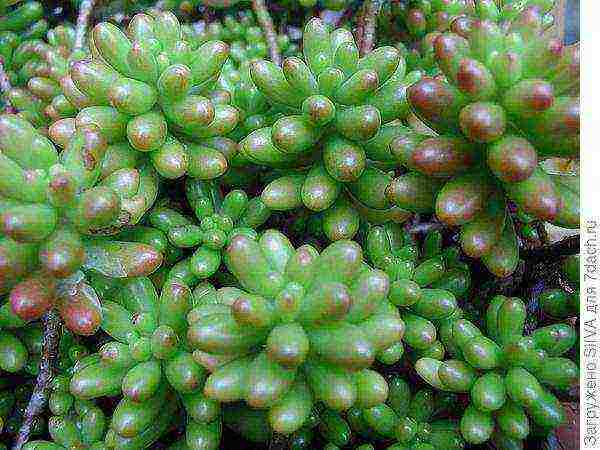
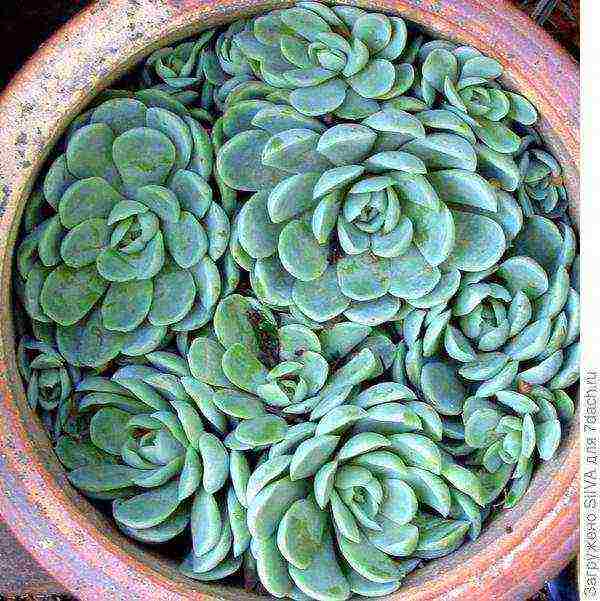
4. Cacti
Almost all species are demanding on light, good illumination is the key to the longevity and strength of cacti. Now buying a cactus will not be difficult, but the choice will make you think. The times when the word "cactus" meant "evergreen thorns" are long gone. Not only the kitchen, but also the rest of the premises can be transformed by the presence of such plants.
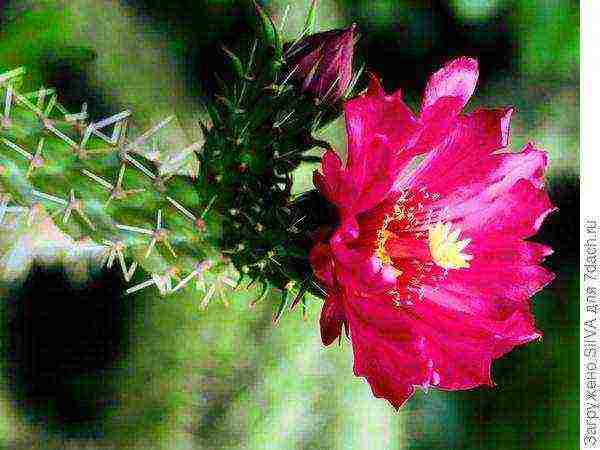
Some of my cacti can also pleasantly surprise with flowers (Gymnokalycium Mikhanovich).
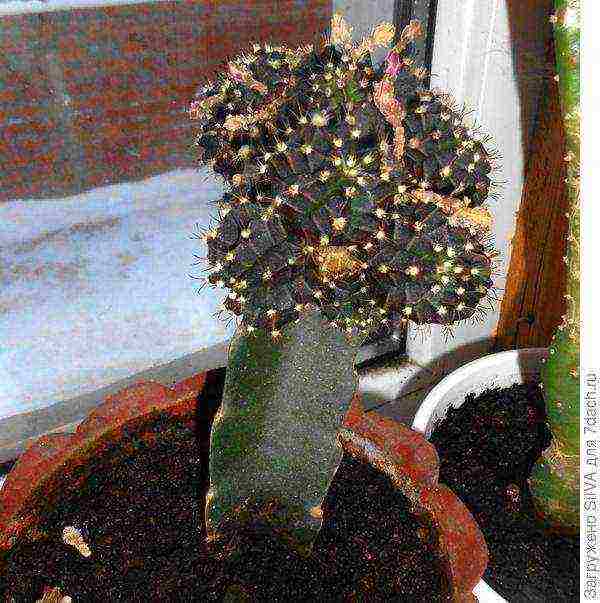
But green cacti also give me and my guests positive emotions. Flowers feel good in houses where they are loved and taken care of, if peace reigns at home, then the plants will be calm there, and the energy will be positive.

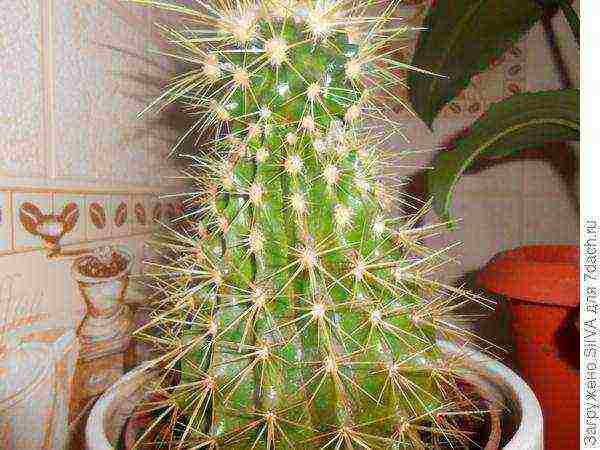

And this is only a small part of all the cacti living with us.
5. Crotons (Codiaeum)
Gained popularity due to the decorativeness of the leaves. With a sufficient amount of light, their color is bright and saturated, in the shade the croton is bad, this can be immediately understood by its leaves. Young plants need watering and good lighting, otherwise you risk being left without leaves at all.

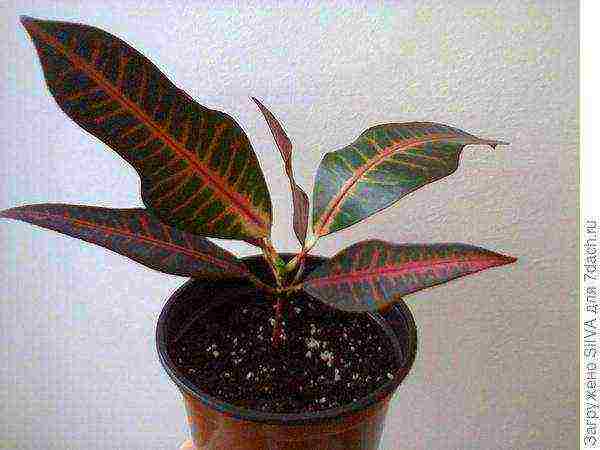
6. Euphorbia
When buying milkweed, it is worth considering that its juice is poisonous. It can harm animals, and it is worth transplanting it with gloves. I noticed that strong juicing occurs in the fall, when it fades and the seeds ripen.
- Euphorbia- it contains a poisonous substance (euphorbin) contained in the resins that entangle the seed pods. Has lived with me for many years, stands on the windowsill out of reach of children, pleases the eye!
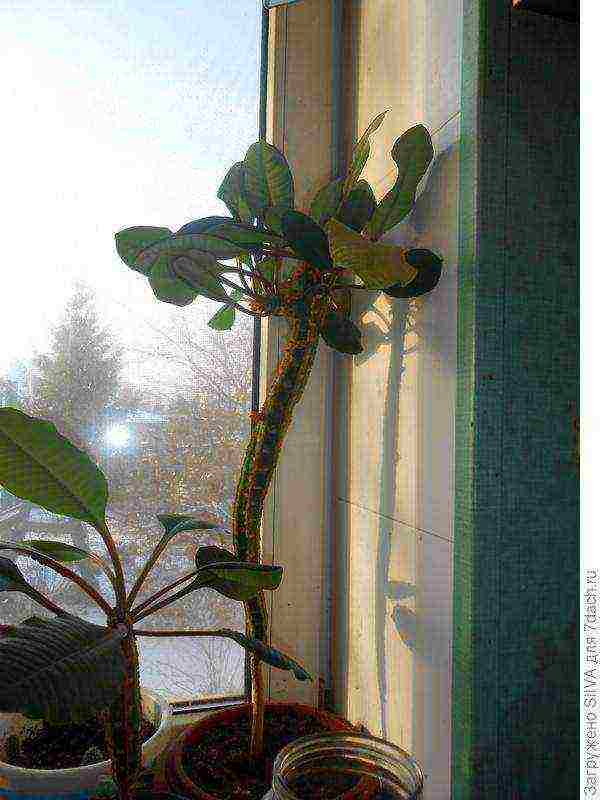
- Christmas star(poinsettia) also belongs to the euphorbia family, and children and cats should be protected from it.


7. Aloe
Easy to grow, with fleshy leaves, often used in folk medicine. They belong to succulents. In our everyday life, as a rule, 4 types are used: variegated aloe, squat aloe, pleasant aloe, awesome aloe. It does not need spraying.
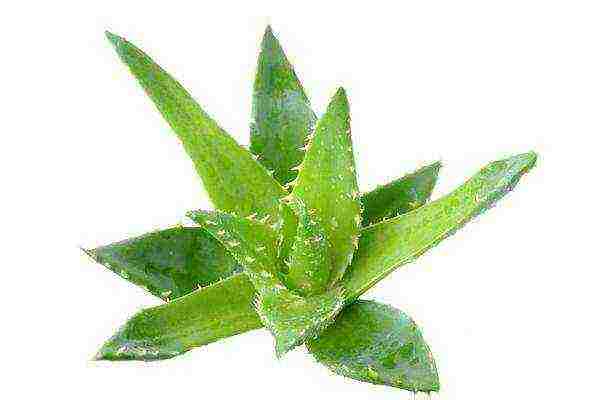
8. Cyclamen
These beautiful flowers are photophilous, but prefer diffused light, the most interesting thing is that during flowering, the temperature for them should not be higher than 15
° C. Watering abundantly, during the period of growth and development, it is undesirable to allow the soil to dry out.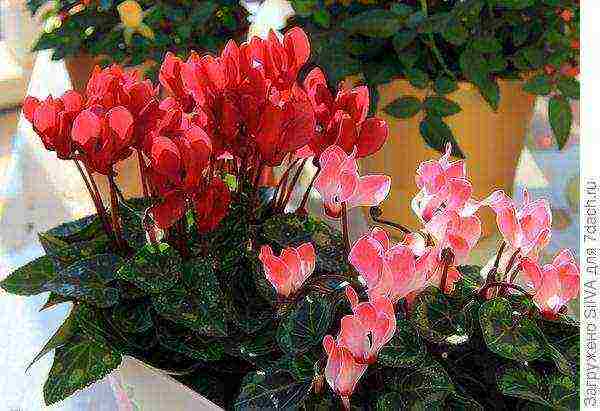
9. Passionflower
Popular name of the flower
passionflower ... Very light-requiring. It has several varieties. The flowers are beautiful and unusual, but at the same time short-lived. Grown as an ampelous plant. The flowers of blue passionflower (climbing liana) are solitary, about 10 cm in diameter with a light delicate aroma. The fruit is an orange-colored berry about 6 cm in diameter. In the fall, a period of dormancy begins, therefore, it requires a decrease in temperature.

10. Azalea
Represents the heather family. The main factor for proper cultivation is good moisture. Temperature data is inconsistent. Many sources indicate that azalea loves temperature no more than 18
° C , but many of my friends with oriental windows in the kitchen feel great. The truth still does not like direct sunlight.

11. Catharanthus ("cayenne jasmine")
Summer temperature 25
° C , in winter up to 18
° C ... A bright, sunny location and humid air: these are the main factors for growing.
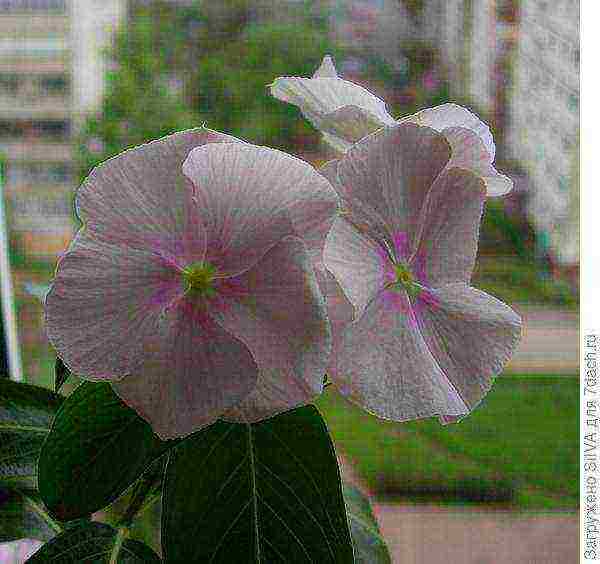

12. Agave
Genus succulents, agave family. Likes bright light, but does not like stagnant water, provide drainage in the pot. He does not like high temperatures in winter.

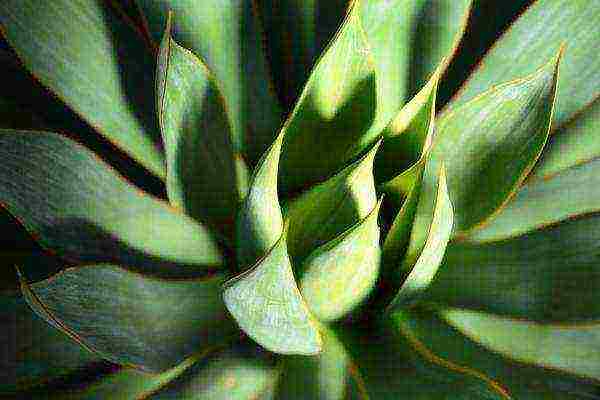
13. Plants from the familytolstyankovy
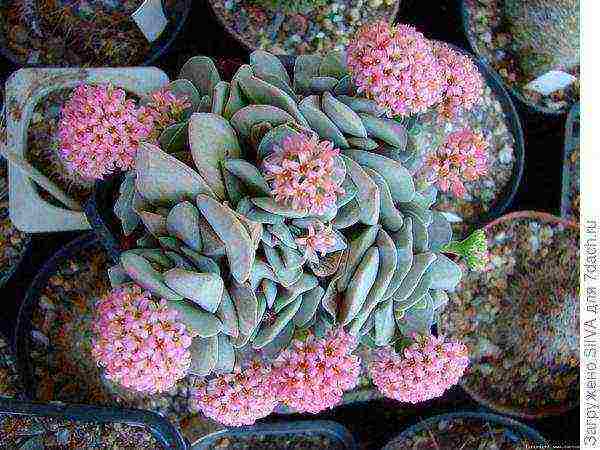
The Tolstyankovs also include
kalanchoe - most often this plant is bought for its bright flowers, collected in beautiful inflorescences. The color of flowers can be absolutely varied, but in some species the leaves themselves are unusual and decorative.
The light-loving plant loves moderate watering, but does not like the withering midday sun. Blooms for about 2 weeks. After flowering, the shoots are shortened and within a month the pot is carried away from the windowsill to a darker room, excluding watering. After the plant has rested, it can be transferred to the windowsill again and watering can be resumed.

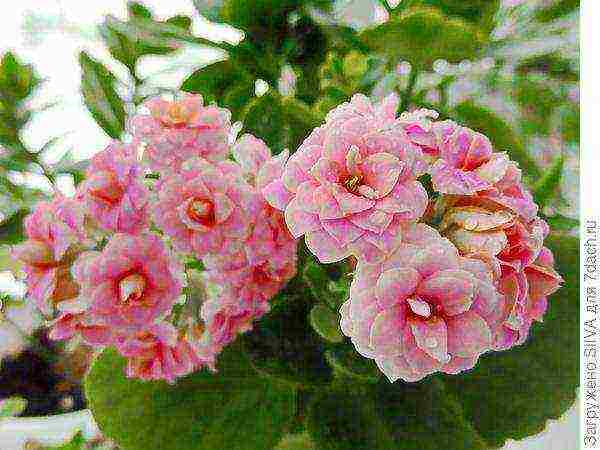
14. Anthurium
A very troublesome flower, I did not take root, but incredibly beautiful. Many housewives and just amateurs, trying to get flowers, put a plastic bag on it or leave it in the bathroom, provoking flowering in pairs. A kitchen with light windows will suit him perfectly, but does not like direct sunlight. It cannot be poured, the roots immediately rot, has 2 main varieties and requires spraying the leaves.
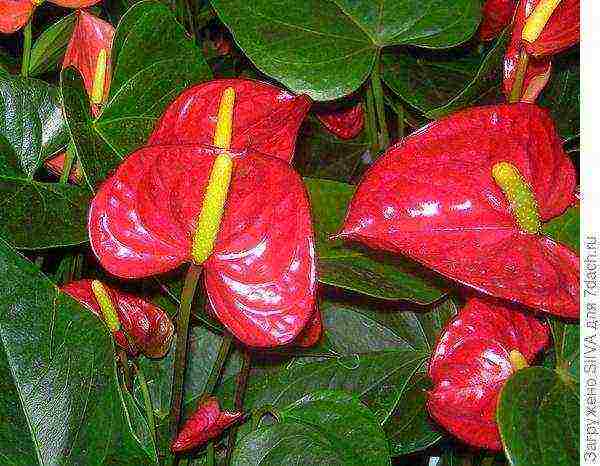
15. Amaryllis, or house lily
I couldn't help but include this plant on the list. This incredibly beautiful plant has a period of winter dormancy, when the temperature should not be higher than 10 ° C, so you will have to take it to a cooler room. I saw him a few years ago visiting in the kitchen. He was not standing directly on the windowsill, but on an impromptu "bar counter", as if separating the dining area from the dining room, the hostess said that he loves diffused light and blooms wonderfully.


16. Pelargonium (geranium)
This flower is familiar to everyone since childhood, we are so used to it that it seems that there is nothing special in it, but this is the greatest delusion. Currently, there are so many varieties of this bright flower that you can lose your head from the variety, you can learn more about it in the article “
Unusual Pelargonium or Common Geranium
«.
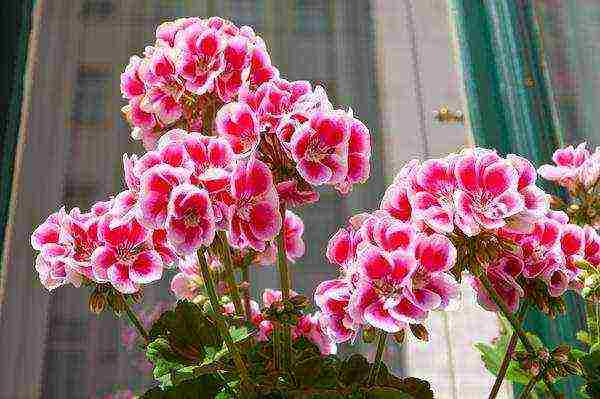
Not many plants are able to withstand direct sunlight. And if you consider that dryness in our latitudes is almost an obligatory companion of the sun - you seemed to have even less choice. But I really want to grow something beautiful on my windowsill! Even if it is southern. I want to tell you about my own little experience.
| Stefanotis perfectly tolerates direct sun. |
So, in order to minimize the scorching effect of the sun, I worked out for myself five little rulesthat really help you get the best out of your solar window sills.
Rule one: the simplest, but often forgotten, - these are necessarily light pots. In dark plants, the root system of plants can overheat. If you don't want to change the pot itself, in the summer, put the plant in a light flower pot, or in a light wicker basket.
Second rule: This humidity... In the bright sun, the soil dries out very quickly. First, provide your pets with abundant and frequent watering (I water 2-3 times a day, but not in the hottest). Further - plants can and should be regularly sprayed with warm water and give them a real shower in the bathroom. Also, many of my plants are on pallets with wet expanded clay. Recently, I have replaced expanded clay with sphagnum moss, as it also has antibacterial properties. Of course, the moss must be constantly moist.
If there is still not enough moisture, you can take a simple mayonnaise bucket, plastic, make holes in the lid, fill with water and put a pot with a plant on top (without a pallet, of course). This method is suitable for plants that do not tolerate dry air - myrtle, for example.
Another great way is to purchase a small decorative fountain. It consumes a little electricity, like one extra light bulb in an apartment, and its benefits are tangible: firstly, it gives a “zest” to the interior, and secondly, it significantly increases the humidity of the air. If this method does not suit you, just place containers with water on the windowsill - these can be ordinary glasses, for example.
Third rule: of course, the choice of plants... My cacti and succulents feel great in the very heat. Haworthia, cacti, milkweed, sanseveria, fat woman, crassula, echinopsis - these are those who will gladly take any dose of sunlight. Compositions and mini-gardens from such plants can look very picturesque. Many others have also passed the “southern windowsill” test. Feel great even without shading jasmine - stephanotis, polyanthus jasmine, sambac, adenophyllum. Bougainvillea is a very flowering plant. I have good tolerance for direct sunlight of Dracaena Song of India, nolina, banana, brugmansia, passionflower, purple tradescantia or netcreasia, pelargonium (leaves turn slightly yellow if it is very hot), chlorophytum, ertendal's plectranthus, hippeastrum, indoor lilies, lemon Garnet.
 |
| Pomegranate with a bud. |
Coleus, irezine herbst need constant monitoring, their leaves instantly droop from the heat without sufficient watering. Rule four: be sure to shade those plants that "burn" in the sun - I have eucharis, tuberous begonias, fuchsias, violets, gloxinia, Mrs. Thompson's clerodendrum, Ugandan clerodendrum, shefflera, streptocarpus, crossandra, indoor mini-rose. I have two ways to protect these plants. The first is tulle, which covers the window glass itself, an “additional curtain”. It can be closed during the hottest time, and opened in the evening. The second way to increase the “survival rate” of more delicate plants is to place them in the second row, after those named in the previous paragraph. Behind dracaena and jasmine, violets grow well in the shade, and before they got burns on the leaves, they did not bloom. Place these plants closer to the corners of the windowsill, where the shadow lasts longer.
Rule five: do not start those plants for which your conditions are contraindicated. Unfortunately, some of your flowers will literally suffer. Move them deeper into the room or refrain from buying them altogether. These are azalea, ferns, spathiphyllum, cyclamen, anthurium, arrowroot, cissus, decorative leafy begonias.Some plants, for example, fatsia, I still manage to grow on the south side. However, be prepared that you will need to spend more efforts, and the result will still not be the same as you would like. For example, it is very difficult for me to grow begonias at home, it is hot and dry for them, and it is also difficult for them to choose an irrigation regime. But I love them anyway!
These are such simple, but important rules, the observance of which will help your plants feel great and delight you with their growth and flowering!
Good day!
Which plants will feel good in rooms with southern windows, their climatic zones (that is, where they come from), which rooms are considered warm for plants - everything in this article.
plants for warm southern windows
I'll start with what kind of rooms are warm. These are those rooms in which the temperature does not drop below 15 ° in winter, well, if for a very short time and rarely, then it is permissible up to 13 °. In short, warm southern rooms are determined by two factors - heat and light.
According to these criteria, east and west rooms with very good lighting are equated to the south windows. But not all plants need a lot of light and warmth in winter. On warm southern windows, you should not grow indoor plants that need peace in winter, it is better to move them to a cooler room for the winter. The fact is that these plants at this time need rather low temperatures, otherwise, if the temperature cannot be sustained, then the decorative flowering species may not bloom later. These flowers are best grown in cold southern rooms.
Shade-loving plants that do not tolerate direct sunlight should be carefully kept in southern rooms. Never place them close to glass.
Representatives of African deserts, tropical and some thermophilic subtropical species are potential inhabitants of warm southern windows.
The characters of the inhabitants of the desert and the inhabitants of the tropics can be very different in some characteristics from each other. Therefore, when choosing flowers for warm rooms with southern windows, you need to take into account the requirements of these plants for well-being and take into account the characteristics of your room.
In the article, with a brief description of the plant, there is an item "Minimum care". It describes the minimum measures that will prevent the plant from dying.
the most unpretentious plants for southern windows
abutilone (indoor maple)
A plant of the Malvaceae family, it is considered an ornamental floral, but it can also pass for an ornamental deciduous. In indoor floriculture, the following varieties are most common.
Abutilon grape-leaved - a medium-sized plant with pubescent leaves, wide, bluish flowers, sitting on long pedicels, collected in a cluster of 3-4 flowers.
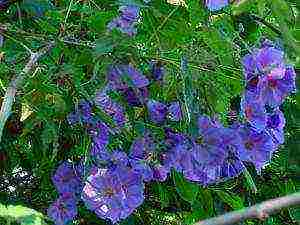
Abutilon hybrid - this abutilon has serrated leaves, light green, drooping flowers, bell-shaped. This species has several varieties with different colors of flowers.
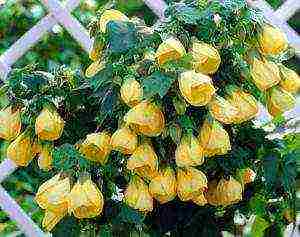
Abutilon Darwin-at home grows up to 1 meter, and in natural conditions it can reach 3 meters. The leaves and most of the other organs of the plant are covered with silky hairs, the leaves are wide, up to 15 cm wide. The flowers are very beautiful, they are collected in 2-3 flowers, up to 5 cm in diameter, bright, orange, with darker veins.
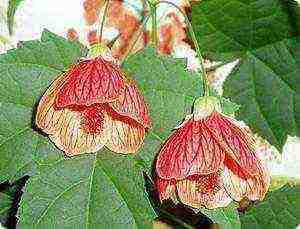
Abutilon megapotamskiy is a half-barometer shrub, with wonderful flowers. Drooping, with a red calyx, yellow petals and purple stamens, they are handsome.
Abutilon striped - in one of the varieties there are double flowers (this is in the Thompson variety).
- Climatic conditions- tropics and humid subtropics. Most of the species originated from South America.
- Moisture: in winter, watering is moderate, in summer, plentiful. Since abutilone is from the tropics, it needs high humidity, if the dryness of the air is higher than necessary, it can begin to shed leaves. Spraying is encouraged, although it can be done without it, the humidity can be increased in other ways.
- Temperature: normally refers to room temperature, in winter temperatures above 15 ° are undesirable, the lower temperature limit in winter is 10 ° C.
- Light: photophilous, withstands direct sunlight, photoperiodism (reaction to the ratio of the dark and daytime) is weak.
- Soil and Nutrition: sandy soil mixtures with a high humus content are suitable (that is, you can add sod, humus or deciduous soil). It is better to feed with organic fertilizers every 10 days, then flowering will be more abundant.
- it is unpretentious to the soil, but good drainage is needed, to feed it when it grows with cuttings in spring or September, with seeds, sprout in 20-25 days.
- Peculiarities: abutilon grows rapidly, up to half a meter per year, spring transplantation, crown pruning is required, and if long shoots are cut off to the hybrid abutilon, it will bloom longer, the tops pinch. In summer you can keep on the balcony.
- Minimal care: watering 2 times a week (if not hot), you can raise the humidity a little by the proximity of containers with water or put saucers with moss next to it. Feed for symptoms of a lack of nutrients.
agapanthus (African lily)
Ornamental flowering plant, lily family.
Umbrella agapanthus is grown in the rooms, the height of the peduncle is up to 1 meter, without the peduncle - 50 cm.The leaves are collected in a root outlet, belt-like dense. The flowers are blue, purple.
It is imperative to observe the dormant period, otherwise its violation may lead to a lack of flowering!
- Climatic conditions: rocks and mountains in the tropics and subtropics of South Africa.
- Moisture: moderate watering before flowering, after flowering they must be sharply reduced.
- Temperature: in summer - room, in winter - not lower than 13 ° С.
- Light: photophilous.
- Soil and nutrition: undemanding to the soil, but good drainage is needed, feed only when the need arises, that is, when signs of a lack of nutrients appear.
- Reproduction: seeds and when transplanting by dividing rhizomes.
- Peculiarities: transplant no more than once every 2-3 years. Carefully remove faded peduncles.
adenium
Arboreal succulent, kutrovy family.
The plant is beautiful and unpretentious, in culture, thick adenium is most often found. This plant is up to 2 m tall with a thick stem and thick roots protruding from the ground.
I found a photo of adenium in its natural environment in the depths of the Internet.
Small rosettes of leaves stick out at the tops of the shoots, up to 4 cm long and 3 cm wide. the top is shiny and dark green, and the bottom is lighter and matte. The flowers are tubular, bright pink, collected in a thyroid inflorescence.
- Climatic conditions: African deserts from the Arabian Peninsula to Kenya.
- Moisture: in the summer to water abundantly, if it is too dry during this period, it can shed the leaves, in the winter it is very scarce, the lump should be almost dry. Does not tolerate stagnant water, which means good drainage is needed. He is not interested in atmospheric humidity, but sometimes he needs to wash the leaves with warm water.
- Temperature: in summer - room, in winter - not lower than 15 °; can, but for a very short time, withstand 5 ° C.
- Light: photophilous, feels good in direct sunlight.
- Soil and Nutrition: unpretentious, but good drainage is needed. Feed, if necessary, with special fertilizers for cacti and succulents.
- Reproduction: more often by seeds, less often by cuttings.
- Peculiarities: frequent transplants are not needed, the roots should protrude above the ground, this is natural for adenium.
acantoripsalis
Epiphytic (that is, growing on trees) shrub-like cactus.
These cacti bloom in late winter and early spring. The dormant period is short and occurs in the fall.
Acantoripsalis monocanta - shoots "mature" only by 4-5 years, flat, belt-like. The flowers are orange, bell-shaped, large.
Acantoripsalis Howletta - this one has white flowers.
- Moisture: oddly enough for a cactus, but loves moisture, especially during budding and flowering.At other times, before the beginning of budding, it is necessary to let the earthy coma sometimes dry out, this contributes to better flowering. In the fall, watering is reduced.
- Temperature: it is not necessary to lower the temperature in winter, 15 ° - 18 ° is normal.
- Light: unpretentious.
- Soil and Nutrition: unpretentious to the soil, but good drainage is required. It's a good idea to add brick chips or expanded clay to the earthen mixture. During the period of budding and flowering, it responds well to feeding with special fertilizers for cacti or succulents, you can use ordinary complex fertilizers, but the dosage should be halved compared to other non-cacti and non-succulent plants.
- Reproduction: cuttings or seeds that sprout at t 20 ° -25 ° C.
- Peculiarities: recovers well if damaged.
allamanda
Ornamental flowering plant, kutrovy family.
Allamanda laxative is a climbing shrub with lanceolate leaves, bright green in color. Bell-shaped flowers, up to 7 cm in diameter, collected in an apical raceme. Blooms from May to September.
- Climatic conditions: tropics of America.
- Moisture: watering is plentiful, from August to January, this is a dormant period for Allamand, moderate.
- Temperature: in winter - not lower than 16 °, the rest of the time - moderate.
- Light: in general, western and eastern windows are optimal for this plant, since this plant needs bright, but diffused light.
- The soil: a mixture of turf, leaf, humus and peat land in a ratio of 1: 2: 1: 2 and a little sand.
- Reproduction: in the spring with green and semi-lignified cuttings.
- Peculiarities: you need support, pruning, pinching (pinching) to form the crown.
aloe
It seems that this is the most unpretentious plant, it is afraid only of the cold and does not like excessive moisture. Depending on the type of aloe, they can be ground cover, shrubs, ornamental deciduous. All aloe are succulents, but very different from each other. There are stemless, there are treelike with fleshy leaves.
Aloe is tree-like. Under natural conditions, it grows as a tree up to 3 meters high, in indoor conditions it is a shrub. Leaves can be up to 60 cm long, pointed at the end, with curved teeth at the edges, bluish-green. Flowers up to 2 cm long, racemose inflorescences, yellowish-pink. Aloe is famous for its medicinal properties.
Aloe Marlota
Treelike perennial, with thorns along the edges, leaves up to 50 cm long, bluish-green.
Aloe variegated
A plant with a shortened stem, on the leaves there are white transverse stripes of dashed spots, the leaves are dark green, arranged in a spiral shape
aloe ciliate
This aloe can be grown as ampelous. It has a thin and branching stem, leaves up to 15 cm long, grayish-green with white denticles along the edges.
Less common than these, there are aloe Baineza, aloe whitish, aloe boemi, aloe gavorthiform (leaves with pronounced ribs, and thick thorns at the edges), aloe cap-shaped, aloe pretty, aloe multifoliate (leaves are arranged spiral-shaped, aloe flattened leaves are arranged in a fan-like rosette), aloe is terrible and aloe is cap-shaped.
- Climatic conditions: deserts of America and Africa.
- Moisture: watering plentiful in summer, rare in winter.
- Temperature: in winter from 12 ° to 16 °.
- Light: photophilous, but can tolerate moderate lighting.
- The soil: soil mixture "For succulents", fertilization is not necessary.
- Reproduction: most often by offspring, it is possible with apical cuttings, rarely leafy, seeds. rooted in the sand
- Features: it is good to replant it every year, but the pots should not be very large. In order for the aloe to develop better, it must be regularly ventilated.
andreder
Liana is decorative and flowering of the Basell family.
In indoor conditions, cordifolia is more common. In this climbing liana, shoots sometimes reach several meters in length. The leaves, according to the name, are heart-shaped, fleshy and juicy.The flowers are very fragrant, white, gathered in a panicle inflorescence. The andredera blooms in late summer and early autumn.
- Climatic conditions: tropics of South America, less commonly found in North America and Asia.
- Moisture: watering is abundant, but does not like excessive moisture when the tubers germinate, then watering should be moderate. It is not necessary to spray.
- Temperature: room or higher, in warm summer it can be good on the balcony.
- Light: photophilous, tolerates direct sunlight, but from a very bright sun it can begin to turn yellow, With a lack of light, the shoots stretch out strongly, with a lack of light, it can get sick with etiolation, this is when the shoots are stretched out, the leaves become smaller, the petioles and shoots turn pale.
- Soil and nutrition: the soil needs fertile, loose, humus-rich and well-drained. feed 2 times a month with complex fertilizer, organic matter (mullein, slurry)
- Peculiarities: since this is a liana, then she definitely needs support. Plant immediately in large pots, because liana is very difficult to transplant without loss. For the winter, the upper part may die off, then the pot of tubers should be placed in a cool place until spring.
- Minimal care: regular abundant watering and feeding.
asklepis
An ornamental flowering plant from the gorse family. In indoor floriculture, Asklepis Kurassavsky is more common than others. It is a continually flowering shrub about 80 cm in height, orange flowers with reddish sepals, located on the tops of the stems in corymbose inflorescences. The entire stem of the plant is covered with dark green leaves.
- Climatic conditions: tropics and subtropics of Africa and America.
- Moisture: during the flowering period, water moderately, after flowering it is enough that the earth does not dry out, that is, watering is very economical.
- Temperature: if the room is warm, then no additional conditions are needed.
- Light: photophilous, but also feels good on large northern warm windows.
- Soil and Nutrition: the earthen mixture must be nutritious. If the land is fertile enough, then feeding is not necessary.
- Reproduction: seeds and cuttings. Cuttings are taken from young shoots and it must be borne in mind that Asclepis has a milky sap, therefore, when cutting, you need to adhere to special methods for plants with lactifiers.
- Peculiarities: loses its decorative effect with age, so you need to replace it with a young plant more often. And the rest, as you can see, is a rather unpretentious plant.
asparagus (asparagus)
Ornamental deciduous plant of the lily family.
Asparagus pinnate (chill) is a semi-shrub, curly, lateral shoots form a kind of triangular fern leaves.
Asparagus Sprenger is a subshrub, climbing shoots, up to 1.5 meters long, blooms with small fragrant flowers.
- Climatic conditions: almost all grow in the subtropics, feathery in the savannah.
- Moisture: during the period of active growth, watering is plentiful, the dormant period for asparagus is not very pronounced, but still, approximately, in November-February, watering is economical.
- Temperature: rather thermophilic, during rest 15 ° -17 °.
- Light: can be grown not only on the southern windows, since although asparagus is photophilous, it tolerates both shade and partial shade, but it will not bloom in the shade.
- Soil and Nutrition: an earthen mixture is suitable for universal use, you can add bone meal. During active growth, alternate mineral fertilizing with organic matter.
- Reproduction: dividing the bush and seeds.
- Peculiarities: in summer it can be taken out into the open air. Supports and garters can be used.
bryophyllum
Succulent plant of the jungle family, dwarf shrubs or shrubs.
The genus Bryophyllum is confused with the genus Kalanchoe. But it is in bryophyllum that propagation buds appear along the edges of the leaves, similar to small plants with roots. Bryophyllum is a rather unpretentious plant. In room culture, the following two types are most often found.
Bryophyllum Daygremont, (live-bearer).
The leaves of this shrub, reaching 1 m in height, resemble the leaves of nettle or coleus. But in the bryophyllum they are fleshy, with age they bend their tip downward, brown-red or brown spots are scattered over the dark olive-green leaf plate. Reproduction buds are formed along the edges of the leaves. It has medicinal properties.
Bryophyllum is pinnate.
This meter-long semi-shrub has young ovoid leaves, and propagation buds are also formed along the edges.
- Climatic conditions: subtropics.
- Moisture: water abundantly in summer, but rarely; in winter, very moderately.
- Temperature: adult plants require a temperature of 12 ° -14 ° in winter, while young plants need a little higher.
- Light: sun-loving, blooms with a short day, if you need flowering in spring and summer, then the daylight will need to be artificially reduced to 12 hours.
- Soil and Nutrition: if an earthen mixture is used that is not universal for succulents, then feeding is minimized. In general, they are fed with solutions of mineral and organic fertilizers. During the budding period, they are fed with fertilizers with a high phosphorus content or phosphorus fertilizers.
- Reproduction: mainly by propagation buds, less often by leaf cuttings, cuttings of peduncles and seeds. Seeds germinate at t ° 16 ° -18 °. dry cuttings before planting, root in the sand.
- Peculiarities: when the plant takes root, the top is pinched off. Transplant or reload annually.
valotta
An ornamental flowering plant of the amaryllis family. In the rooms, you can most often see the purple valotta. The leaves are long, up to half a meter, dark green. Peduncle up to 30 cm, inflorescence - umbrella, purple or red flowers.
- Climatic conditions: South Africa.
- Moisture: abundant watering, but moderate from October to December.
- Temperature: most of the year 22 ° and above, and in November and December 16 ° -18 °.
- Light: in January and February the illumination is bright, the rest of the time it is moderate and it is better to move away from the glass.
- Soil and Nutrition: an earthen mixture of leaf, humus and sod land in a ratio of 4: 2: 1; from March to September, feeding with mullein solution.
- Reproduction: onions - children.
- Peculiarities: can be planted in the garden in summer. When planting, you need to ensure that the bulb is not completely buried, about 1/3 should protrude out of the ground.
haworthia (haworthia)
Decorative leafy succulent of the lily family.
Pearl havortia - dense basal rosette of leaves up to 15 cm in diameter. The leaves are dark green, triangular, with small white warts located on the underside of the leaves.
Gavorthia is winding.
In the winding city, the leaves are arranged in a spiral, in three rows.
scaphoid havortia
The leaves are almost the same length and width, about 5 cm, soft, light green, there is a bristle on the upper narrowed part of the leaf.
Haworthia drawn
It differs from the pearl in the arrangement of stripes of warts, in the drawn-out they are located longitudinally.
Haworthia Reinwardt
This havortia has a pronounced stem up to 25 cm long. The leaves are dark green to reddish green, triangular, thick. Varieties of Reinwardt's gavorthia differ in leaf size and warts.
gavortia chess
instead of warts on thick leaves, there is a characteristic pattern on the staggered gavortia, there are many leaves themselves, no more than 10 pieces.
In addition to these, the following varieties can be found in the rooms: dusty havortia (protruding transverse stripes, lighter than brownish-green leaves), chopped off havortia (the upper part, as chopped off), ribbon havortia (in the upper part of the leaf there is a white spot, along the edges small light cloves), variegated havortia (below the leaf is covered with bright white stripes).
- Climatic conditions: deserts of South Africa.
- Moisture: constant moderate humidity is needed, watering is almost economical (havortia comes from the desert).
- Temperature: all year round 18 ° -20 °.
- Light: moderate lighting.
- The soil: earthen mixture for succulents, feeding is optional.
- Reproduction: seeds, leafy cuttings, offspring.
- Peculiarities: annual transplant.
hemantus
ornamental flowering plant of the Amaryllis family, genus Hemantus.
Bulbous perennial plant that forms basal rosettes of leaves and flowers collected in an umbrella inflorescence (such as onion inflorescences).
white-flowered hemantus (elephant ear)
The round bulb is immersed in the soil only halfway, the leaves are 8 cm wide and 20 cm long. The inflorescence resembles a ball, the pistils are white and determine the color of the inflorescence. Red fruits are decorative.
Gemantus Katarina
In this species, the leaves are wavy at the edges, light green, the flowers are collected in an umbrella inflorescence, sometimes they look like a ball, bright scarlet, sit on a thick peduncle up to 60 cm long.
- Climatic conditions: rocky places in the tropics of South Africa and South America.
- moisture: watering is moderate throughout the year.
- Temperature: in summer - room, in winter for Katarina's hemantus not lower than 18 °, and white-flowered hemantus can withstand a decrease of up to 13 °.
- Light: the plant loves light, so southern windows are the best option, but white-flowered hemantus can grow even on northern windows.
- Soil and Nutrition: the earthen mixture is universal, feed with a solution of a mullein or other organic fertilizer before flowering.
- Reproduction: onions - children.
- Peculiarities: Hemantus can cohabit in one container with many succulents. Transplant every two to three years. It is necessary to transplant carefully so as not to damage the roots, otherwise they can easily rot and get sick.
gesneria
An ornamental flowering plant of the Gesneriaceae family.
Under indoor conditions, hybrid Gesneria is grown. It is a herbaceous perennial with bright green and pubescent stems and leaves. The flowers are red, collected at the top of the stem. Gesneria has a pronounced dormant period, while only tubers remain. This period lasts from October to December, and blooms from April to June.
- Climatic conditions: tropics of America.
- Moisture: the plant is hygrophilous and does not like cold water; water at room temperature is needed for irrigation. Does not like spraying, but likes high atmospheric humidity. When watering, you need to make sure that water does not get on the leaves and flowers.
- Temperature: thermophilic, but cannot stand the dry summer heat.
- Light: does not require a special light regime, but even closer to light-loving ones.
- Soil and Nutrition: ideally, an earthen mixture with notes: "For violets", "For gloxinia", "For Gesneriai" is suitable. Drainage is obligatory. It is better to feed organics during active vegetation.
- Reproduction: by dividing rhizomes, leaf and stem cuttings, if artificial pollination is carried out, then it can be propagated by seeds that are not buried in the ground, but covered with glass.
- Peculiarities: since the dormant period is expressed in gesneria, the aboveground part begins to die off in October. At this time, you need to make sure that the earthen lump does not dry out.
- Minimal care: in the summer, water once every 2-3 days, in the winter every 10 days. Create a nearby source of increased atmospheric humidity, if the earthen mixture is enriched with nutrients, then additional fertilizing is not needed.
ginura
Ampel, ornamental deciduous plant of the Asteraceae family.
Ginura is orange. Both the stem and leaves are covered with purple hairs, and this gives the plant a very interesting look, a little unearthly. Alien plant, in short))). Leaves up to 15 cm long, soft to the touch. It is better to remove the flowers immediately, they are orange and a little like dandelions. Blooms in May-June.
Ginura wicker- in this species, the leaves are two times shorter than in orange and it is found in indoor floriculture less often than orange.
- Climatic conditions: tropics of Asia and Africa.
- Moisture: water 2-3 times a week, but in summer it is abundant, in winter it is moderate.
- Temperature: all year round for ginur, the optimum temperature will be 18 ° -22 ° /
- Light: does not tolerate direct sunlight, although photophilous.
- The soil: any loose and nutritious earthen mixture.
- Reproduction: cuttings that are rooted in the sand.
- Peculiarities: grows faster, therefore it ages quickly, so every 3-4 years you need to update
decabelone
Ornamental flowering succulent from the Grimaceae family.
Dekabelone refined and large-flowered differ in height (refined lower, 15 cm and large-flowered up to 20 cm), the number of faces (large-flowered, there are more of them, up to 14, and refined up to 8) and the size of the flower.
- Climatic conditions: deserts and semi-deserts of Africa.
- Moisture: water sparingly in summer, 1-2 times a week, but do not water on cloudy days, economical watering in winter, in winter you need to be more careful with this, as decabelone can rot with frequent watering.
- Temperature: 18 ° and in winter and summer is the optimum temperature.
- Light: tolerates direct sunlight, photophilous.
- The soil: earthen mixture for succulents with the addition of charcoal.
- Reproduction: cuttings, seeds, grafting. Decabelone can be grafted on ceropegia and stocks.
- Peculiarities: loves fresh air. To do this, you can open windows.
dracaena (dragon tree)
Ornamental-deciduous plant, agave family, some classify it as liliaceae. Dracaena is a shrub or tree with hard leaves, rarely blooms, flowers are not interesting. Dracaena can be placed in any room that will not be very cold, but in the warm southern ones it is most comfortable. There are variegated forms, these need to be shaded or placed at some distance from the glass.
Common room shapes are listed below.
fragrant dracaena
Dracaena deremskaya- leaves are large, up to 50 cm and 5 cm wide; fragrant dracaena- leaves are slightly wavy at the edges, belt-like; Dracaena Hooker- similar to fragrant, but the leaves are even narrower; dracaena canary- the only drawback for growing in a room is its large size (under natural conditions, a tree can reach 18 m in height), leaves up to 60 cm, leathery, grayish-green; Dracaena Sander- the leaves are much smaller than those of the previous forms, only up to 3 cm, monochromatic green, narrow; dracaena waist-shaped leaves reach 70 cm in length, round-ovate with a pointed end.
- Climatic conditions: tropics, subtropics, savannas of Africa.
- Moisture: since dracaena tolerates drying more easily than waterlogging, then watering is moderate both in frequency and quantity. In the heat, an increase in humidity and spraying are needed.
- Temperature- all year round 18 ° -20 °, some (fragrant, Hooker, Canary) tolerate cooler rooms.
- Light: not capricious.
- Soil and Nutrition: the best soil option is 2 For dracaena, ”but soil for palm trees will do. In the summer, feeding with solutions of mineral and organic fertilizers.
- Reproduction:- apical cuttings or longitudinal division of the stem. Some species can be propagated by air layers.
- Peculiarity: long-liver.
- Minimal care: watering 2 times a week.
jasmine
Olive family, decorative flowering. As a houseplant, several species are grown, but suitable for southern rooms jasmine sambac... It is a shrub with straight and climbing stems, the leaves are opposite, light green, up to 10 cm long. The flowers are white, 2 cm in diameter, there are double and semi-double forms.
- Climatic conditions: tropics of Asia.
- Moisture: in summer - abundant watering and spraying, in winter - moderate watering.
- Temperature: in winter - 15 ° -16 °, higher is not desirable, lower will endure.
- Light: very light-requiring.
- Soil and Nutrition: the soils are light and nutritious. During the period of active growth, alternating fertilizing with organic and mineral or complex fertilizers (in no case during the dormant period).
- Reproduction: cuttings and layering, rooted in water or sand. takes root very slowly.
- Peculiarities: if you break the dormant period, then flowering may stop.Well, in order to improve flowering, in the spring you need to remove the weak and shorten the long shoots. The cuttings can be used as cuttings.
- Minimal care: Watering 2-3 times a week in summer, 1-2 times in winter. To increase the atmospheric flag, it is enough to put a container with water next to it, and instead of liquid fertilizing, use dry fertilizer sticks. But the most difficult thing is to ensure a dormant period, for this you need to begin to reduce watering in the fall and completely stop feeding.
conophytum
Groundcover succulent, mesimbriantem family. In its natural habitat, this plant completely covers the soil, forms dense sod. It has a very shortened stem, partially or completely fleshy leaves fused together, forming rounded or two-lobed bodies.
There are conophytums similar to an inverted cone with a concave top, there are those that look like a heart, of various colors and sizes, there are 3.5 cm in height, there are also 5 cm.The flowers are yellow, orange, white, the sizes are also different and 1.7 cm in diameter , and 3 cm.
- Climatic conditions: South Africa, deserts and semi-deserts.
- Moisture: moderate watering in summer, economical in winter, if overmoistened, it can rot.
- Temperature: in winter not higher than 14 ° and not lower than 16 °.
- Light: photophilous, and very much.
- Soil and nutrition: optimal earthen mixture for succulents. In general, they like very moisture-permeable soil made of sand, red clay and leafy humus (1: 0.5: 1). Nutrition is only needed if there are signs of nutritional deficiencies.
- Reproduction: by seeds and dividing the sod.
ground plant (senezio)
On the Internet, a sea of photos of various species of this plant, I chose the most that seemed interesting and different from each other in appearance.
- Climatic conditions: originally from the tropics of Africa.
- Moisture: Water in moderation throughout the year.
- Temperature: in winter 18 ° -20 °.
- The soil: an earthen mixture is suitable for succulents.
- Reproduction: by seed or cuttings in early spring (March).
- Peculiarities: does not like changes in his life))) that is, drastic changes in content.
lithops
groundcover succulent, mesimbriantem family.
- Climatic conditions: deserts and semi-deserts of South Africa.
- Moisture: moderate watering in summer and economical in winter.
- Temperature: in winter - 14 ° -16 °
- Light: very light-requiring.
- Soil and Nutrition: soil for succulents, feed when signs of nutritional deficiency appear.
- Reproduction: seeds and cuttings.
mesimbriantemum
The family is mesimbriantemic.
- Climatic conditions: South Africa.
- Moisture: in the summer to water in moderation, in the winter you can save on watering))).
- Light: loves light.
- The soil: "For succulents", feeding, if only necessary, if there are signs of nutritional deficiencies.
- Reproduction: seeds and cuttings from shoots.
sedum
Groundcover succulent from the jungle family.
- Climatic conditions: these are subtropics and latitudes with a temperate climate.
- Moisture: in winter, water moderately, a little more generously in summer.
- Temperature: in winter - 14 ° -16 °, but they grow even at higher temperatures.
- Light: sun-loving plant.
- The soil: any sandy, loose and nutritious mixture with mandatory drainage.
- Reproduction: seeds, dividing the bush, cuttings.
- Peculiarities: when transplanting, be careful, as the roots of stonecrops are easily damaged.
palm trees
General care instructions:
- Climatic conditions: most of the tropics of Africa, some have adapted to live in the subtropics, but it is still correct to treat palms as tropical trees.
- Moisture: in spring and summer, watering is rare, but abundant (well, like a tropical rain), in winter - in moderation, but do not overdry. If this happened and the leaves turned yellow from overdrying, then cut off such leaves. But you need to cut them on dry, not on living tissue, so that a dry strip remains above the living place.Spray in summer, in winter you can only wash it, you can even less often than once a month. If you water normally, and the leaves still turn yellow, then the matter is in the increased dryness of the air, you need to increase the atmospheric humidity.
- Temperature: optimal t ° 16 ° - 22 °, small deviations are not a problem for many species.
- Light: photophilous, but with age they can tolerate shade.
- Soil and nutrition: there are special mixtures "For palms", you can use soils for dracaena or yucca. As a good option for a young plant, such a soil composition: sod, leafy, humus soil and sand in a ratio of 2: 2: 2: 1. As the palm tree matures, it needs to increase the proportion of sod land.
- Reproduction: seeds. They need to be sown in a mixture of peat, sand and chopped sphagnum, grown when heated.
- Peculiarities: you need to turn towards the light. Transplant: young - annually, old - once every 2-3 years, large, tubular - once every 5-6 years. Containers for palm trees should be higher rather than wider. Palms can acclimatize under many conditions, you can even experiment with them, only you need to do this very gradually, with sudden changes, even for the better, they can get sick and even die.
govea- originally from Australia, where, in natural conditions, the leaves of this palm tree reach 4 meters in length.
Howa Forster- leaves are not curved, tolerates dry air.
govea belmora- petioles are short, reddish, leaves are large and curved.
Livistona- the leaves are fan-shaped, up to 2 meters in diameter. The palm tree grows very quickly.
Rapis- a native of the subtropics of southern China. Low, bushy with leaves on short fibrous petioles, dark green.
- Reproduction: in addition to seeds, they are also offspring.
- Peculiarities: Feels good even at 12 °.
Ropalostilis- was born on Norfolk Island.
Peculiarity: in a young plant, the stem is bent and a so-called heel is obtained. This is a norm, not a defect, nothing needs to be corrected, otherwise you can destroy the plant.
Sabal- from the subtropics of the United States. In natural conditions, only up to 2.5 m in height.
trachycarpus- from East Asia. In winter, it can live even at 5 ° -7 °, if there is no frost, then it can live in open ground.
Hamedorea is the subtropics of Mexico. They love warmth and at t 18 ° -22 ° they grow much faster than in cooler rooms, requires less watering, tolerates dry air well, tolerates shade, it is necessary to add humus to the soil. (Well, he likes to eat)
pachypodium
Succulent, but tree-like from the kutrovy family.
In nature, they grow up to 8 m in height. Looks like a cactus with a tuft of leaves on top.
Pachypodium Lamera- leaves up to 40 cm long, the stem is poorly developed, barrel-shaped. The flowers are large, white, but rarely blooms in the room.
Pachypodium short-stemmed- the stem, as the name suggests, is very short, and it can be wider in width than in length, the flowers are large, pale yellow.
Pachypodium Sounders- the stem is just like a ball of gray-green color. The flowers are medium, white with a pink stripe.
- Climatic conditions: deserts and semi-deserts of South and South-West Africa and the island of Madagascar.
- Moisture: if it dries up, it can shed the leaves, so water it abundantly in summer, in winter you can save on water, and so that the lump remains almost dry. Wash the leaves and stems with warm water, occasionally, to prevent pests.
- Temperature: in summer - indoor, in winter - 15 °, for a short time it can withstand a decrease of up to 5 °.
- Light: photophilous, direct sunlight on the problem.
- Soil and Nutrition: good drainage. Feed when you see signs of nutrient deficiencies.
- Reproduction: seeds, cuttings can.
- Peculiarities: the juice is poisonous.
plectrantus
Ornamental deciduous plant of the buckwheat family.
There are several types grown in rooms: coleus-shaped plectrantus, shrub plectrantus, oertendali plectrantus.
- Climatic conditions: tropics of Africa, subtropics of Asia and Australia.
- Moisture: water in moderation.
- Temperature: thermophilic, for winter the best temperature is 14 ° -16 °, it can withstand lower temperatures.
- Light: photophilous.
- Soil and nutrition: loose and nutritious. Since it is very sensitive to a lack of nutrients, it is necessary to feed it with mineral and organic fertilizers.
- Peculiarities: be careful - it is often affected by pests.
- Minimum care: mineral sticks, the easiest way to remember to feed the plectrantus.
Ripsalis
Epiphytic (tree-living) ampelous succulent, shoots 40-80 cm long.
Ripsalis Barchela
Rhipsalis is hairy.
Other common types in rooms: ripsalis roll ( flowers look like bells), ripsalis mesimbriantemoid(shoots, like branches of conifers), Ripsalis barren(similar to Barchela, but the fruits are pink), ripsalis strange(triangular shoots), thick-winged ripsalis(articulated shoots, of various shapes, flat), ripsalis Ulle.
- Moisture: either abundant but infrequent watering, or frequent but moderate watering. Sometimes you need to give the earthen person a little dry out, then the plant will bloom better, but it is better to hold such an event not during the budding and flowering period. In the cold season, watering is reduced.
- Temperature: in winter - 15 ° -18 °. Seeds must be germinated at a temperature of 20 ° -25 °.
- Light: unpretentious.
- Soil and nutrition: dredge "For succulents". It is good to add brick chips or expanded clay to the soil. And since the plant needs a good outflow of moisture, drainage is required. During the budding period, feed with special fertilizers for cacti, or half the dose of regular fertilizers.
- Reproduction: cuttings and seeds
piglet (plumbago)
An ornamental flowering ampelous plant from the Lead family.
Cape Pig- a plant with very pretty flowers of a delicate blue color.
- Moisture: it would be good to have high atmospheric humidity and water in moderation.
- Temperature: in winter not lower than 15 °, optimal - from 17 ° to 24 °.
- Light: light-loving plant.
- Soil and Nutrition: not capricious in this regard, but if you feed it, it will be more joyful to bloom.
- Reproduction: cuttings and seeds.
Selenicereus (queen of the night)
This is an ampelous cactus, valued for its flowers, very large (up to 20 centimeters in diameter), blooms in June-July.
- Moisture: accustomed to the fact that cacti do not like moisture very much, but this is not the case, they are hygrophilous, but for good flowering it is necessary that the lump dries out sometimes. At the time when the buds appear, water abundantly without drying out the earth, during flowering we continue to water abundantly. In the fall, we begin to save water on irrigation.
- Temperature: in winter, the optimum temperature will be 15 ° -18 °.
- Light: does not require special conditions, but still prefers more light, then it develops better.
- Soil and Nutrition: the soil should be well-drained, it is good to add expanded clay or brick chips to it. If this cactus is fed during budding or flowering with cactus fertilizer or the usual, but in half dose, it will be grateful.
- Reproduction: seeds or cuttings.
Plants that can be placed in a warm room with southern windows include: fat woman (crassula), tunbergia, hoya (wax ivy), zirantus, echeveria, jacobinia.
fat woman
Requires moderate watering all year round, bright lighting.
tunbergia
Watering is moderately abundant, lighting is diffused, temperature is from 13 to 18 in winter.
hoya
Moderate watering, undemanding to temperature, photophilous.
cirantus
Watering is moderate, during the dormant period it is more economical, photophilous, but it also tolerates a small amount of light.
echeveria
In winter, water in moderation, the temperature is from 14 to 16.
Jacobinia
watered Jacobin abundantly in summer and moderately in winter, photophilous, cut off or pinch annually if the plant is young.
Bye Bye.
For some reason, it is believed that most indoor plants do not like the sun and southern windows are the most unsuitable for indoor plants. On many sites, it is advised to shade almost every plant from direct sunlight. Well, except that it is still permissible to put cacti on the southern windows. Before following such "sensible" advice, it is better to think, experiment and use your own common sense.
First of all, no one will dispute the fact that the sun is a real elixir of life, necessary not only for the normal growth and development of plants, but also for the formation of flower buds.
Most of the usual indoor plants come from the tropics or subtropics, where the sun is much brighter than in Moscow. Even under the canopy of the rainforest, the intensity of sunlight is higher than at the latitude of Northern Europe.
But why dracaena, which grows safely under the bright southern sun in tropical regions of Africa, Madagascar, Socotra, the Arabian Peninsula in rainy St. Petersburg, is advised to shade from the sun?
Adenium can be found in the wild in Saudi Arabia, Yemen, Oman, and in the hot and dry regions of the African continent. This plant has a thick bottle-shaped trunk in which it stores moisture during dry periods. Cyperus grows along the banks of the Nile, bokarnea - in Mexico, different types of milkweed in the hot African climate survive well. Palm trees grow in deserts, but at home on the south window they can face a terrible danger in the form of sunburn ?!

South windows are different, despite the fact that they are directed to the same direction of the world. The solar window can be in St. Petersburg or Baku. You will not argue that the intensity of sunlight will be different?
In autumn and winter, a sunny south window may be the only place in an apartment where, in a short day, your indoor flowers will feel normal.
The window can be on the first or second floor. A tree can grow in front of it, creating a slight partial shade with its green leaves in the summer, and letting in all the meager light of a short day in the cold. Or maybe there is a window on the 16th floor without a loggia and not have blinds. The first is almost ideal for all light-loving plants, and on the second, you need to think about what to place.
Why, on sunny windows on the south side, the plants often dry out or look wilted, despite good watering. Why do brown spots and dried patches appear on leaves and flowers?
First, very often in a room culture, not the species that live in the wild are grown, but their hybrids. And hybrids are often specially bred with features such as the ability to grow in a dimly lit place, and they do not tolerate direct sunlight. Therefore, an east or west window is recommended for them, which is guaranteed to give a good result.
Secondly, when spraying and watering, drops of water, remaining on the leaves, act as lenses in the sun and can damage the plants.
Thirdly, by placing an ordinary thermometer on a windowsill illuminated by the sun on a hot summer day, you will notice that the temperature has risen much higher than 30 degrees outside the window. May show around 45-50 degrees or more. The temperature of the flower pots is the same! Especially if they are made of dark glazed ceramics. How do the roots feel in small pots at this temperature? Maybe they just boiled, which is why the plant is sick?
Place flower containers in decorative light-colored pots or keep plants in porous ceramic pots - it quickly evaporates moisture, but when it evaporates, the pot and the ground cool! Water the flowers the way gardeners water their gardens - at sunset or early in the morning, and not running away to work at the beginning of a sunny summer day. Use fabrics or nets to decorate your pots and protect them from the sun.
What plants can be recommended for southern windows? First of all, all kinds of cacti and most succulents. Among the huge variety of milkweed, you can easily choose a plant to your liking.
Almost all representatives of the amaryllis family - hippeastrum, amaryllis, clivia, nerina - are light-loving plants. They bloom in late winter or spring and autumn on the southern window. But many bulbous plants can bloom beautifully on northern windows in spring, if they stood on a balcony or in a garden in summer and autumn.
Most flowering plants only grow buds in good light. Pelargoniums, balsams, fuchsias on the south window bloom in early spring and bloom until late autumn. Anthuriums on the northern window may never bloom or bloom only in summer, and on the southern window they delight with flowers all winter. Hibiscus blooms only in good light. Loves the sun hoya, jasmine. Of the orchids on the south window, you can keep a cattleya, she loves bright light.
From ornamental deciduous plants, all variegated species need good lighting. They can be rearranged to the south window for autumn-winter-spring, and with the onset of heat, they can be moved to a more shaded place. Unpretentious chlorophytum, sansevieria will survive on any window.
What if in the summer it is still too hot on your south window for indoor flowers?
Just move the plants to a side table about a meter from the window. A lightweight tulle curtain will solve all problems with an excess of direct sunlight. You can use blinds to control light in summer.
For large plants such as monstera, dieffenbachia, dracaena, various palms, ficuses, the place near the south window is the most attractive.



